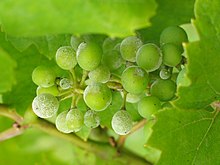
Aurore is a white complex hybrid grape variety produced by French viticulturist Albert Seibel and used for wine production mostly in the United States and Canada. Over a long lifetime, Seibel produced many complex hybrid crosses of Vitis vinifera to American grapes. The Aurore grape is a cross of Seibel 788 and Seibel 29.
Seibel grapes are a group of wine grape varieties which originated with the work of French viticulturist Albert Seibel crossing European wine grape with American grape species to increase disease resistance. They were planted widely in France during the 1950s but have seen decline in recent years because French wine law prohibits hybrid grapes in appellation wine. The grapes are still commonly used as blending grapes in table wine and mass commercial wines. New Zealand, England, and Canada also have plantings of Seibel grapes.
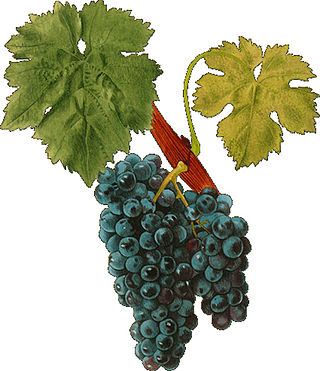
Carignan is a red grape variety of Spanish origin that is more commonly found in French wine but is widely planted throughout the western Mediterranean and around the globe. Along with Aramon, it was considered one of the main grapes responsible for France's wine lake and was a substantial producer in jug wine production in California's Central Valley but in recent years, it has been reborn as a flagship wine for many cellars in the south of France as well as in Catalonia.

Baco blanc or Baco 22A is a French-American hybrid grape variety. It is a cross of Folle blanche and the Noah grape, created in 1898 by the grape breeder François Baco. Folle blanche is its Vitis vinifera parent. Noah, its other parent, is itself a cross of Vitis labrusca and Vitis riparia.

Vidal blanc is a white hybrid grape variety produced from the Vitis vinifera variety Ugni blanc and another hybrid variety, Rayon d'Or. It is a very winter-hardy variety that manages to produce high sugar levels in cold climates with moderate to high acidity.

Hybrid grapes are grape varieties that are the product of a crossing of two or more Vitis species. This is in contrast to crossings between grape varieties of the same species, typically Vitis vinifera, the European grapevine. Hybrid grapes are also referred to as inter-species crossings or "Modern Varieties." Due to their often excellent tolerance to powdery mildew, other fungal diseases, nematodes, and phylloxera, hybrid varieties have, to some extent, become a renewed focus for European breeding programs. The recently developed varieties are examples of newer hybrid grape varieties for European viticulturalists. Several North American breeding programs, such as those at Cornell and the University of Minnesota, focus exclusively on hybrid grapes, with active and successful programs, having created hundreds if not thousands of new varieties.
Villard grapes are French wine hybrid grape created by French horticulturist Bertille Seyve and his father-in-law Victor Villard. They include the dark-skinned Villard noir and the white-wine variety Villard blanc with both being members of the Seyve-Villard grape family. Villard noir is a cross of two other French hybrids, Siebel 6905 and Seibel 7053 created by physician and viticulturist Albert Seibel. Like Villard noir, Villard blanc was produced as a crossing of two Seibel grapes, in this case, Le Subereux and Seibel 6468.
Couderc noir is a red wine hybrid grape that was formerly grown primarily in the South West France wine region and around the Gard département in the Languedoc-Roussillon region. The vine produces high yields and ripens late, creating a wine that is deeply colored with a distinct, earthy flavor. Couderc noir is normally used for mass commercial and table wines.
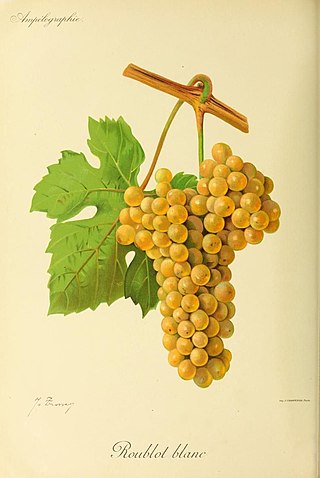
Roublot is a traditional French variety of white wine grape that is a sibling of Chardonnay. It was once quite widely grown near Auxerre.

Calitor or Calitor noir is a red French wine grape variety. It was previously widely cultivated in southern France, in particular in Provence, but is now very rare, almost extinct. Historically used as mainly a blending variety, Calitor gives high yields and produces a light-bodied and lightly colored wine. When grown on hillside sites, it can give a wine of character.

Incrocio Manzoni or Manzoni grapes is a family of grape varieties named after Professor Luigi Manzoni (1888-1968) of Italy's oldest school of oenology located in Conegliano, in the Veneto region. Manzoni created the new grape varieties by selecting, crossing and grafting vines from various vineyards during the 1920s and 1930s. The family includes both white and red grape varieties. Although most Manzonis are grown in northeastern Italy, they are mainly grown in the Piave area of Province of Treviso and are only now starting to be sold commercially in Europe and the United States.
Cascade is a red complex hybrid grape variety that was created by French viticulturist Albert Seibel in the early 20th century in Aubenas, Ardèche, in the Rhône Valley. It has been commercially available in North America since 1938 and has since been planted in Canada and the United States. However, in warmer climates, the grape is highly susceptible to a number of grapevine viruses, which has discouraged plantings of the variety.
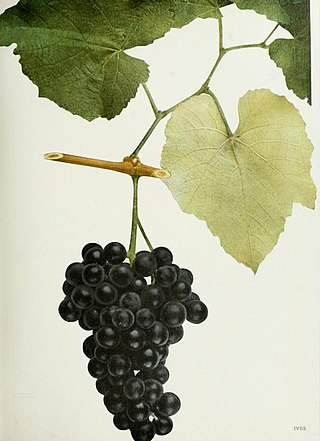
Ives noir is a red hybrid grape variety that is grown throughout the United States. Named after its propagator, Connecticut wine grower Henry Ives, the grape's pedigree and exact origin are unclear. After Prohibition in the United States, Ives was a popular grape used in the production of sweet, port-style wines but saw its plantings steadily decrease throughout the 20th century as the vine's susceptibility to air pollution took its toll.
Landot noir is a red hybrid grape variety that is a crossing of Landal and Villard blanc. Created after a series of trials between 1929-1949, the grape was introduced to Canada and the United States in the 1950s and today can be found in Quebec as well as New Hampshire where a varietal is produced by Jewell Towne Vineyards.
Seyval noir is a red hybrid grape variety that was created in the late 19th century by French horticulturalist Bertille Seyve and his father-in-law Victor Villard from a crossing of two Seibel grapes. The pair used the same two varieties to create the white wine grape Seyval blanc, making the two siblings rather than color mutations of one or the other. The name Seyval comes from a combination of the two men's names.
Cabernet blanc is a white German and Swiss wine grape variety that is a crossing of the French wine grape Cabernet Sauvignon and the hybrid grape Regent. The grape was bred by Swiss grape breeder Valentin Blattner in 1991. Cabernet blanc has strong resistance to most grape disease including botrytis bunch rot, downy and powdery mildew and tends to produce loose clusters of small, thick-skinned grape berries which can hang on the vine late into the harvest season to produce dessert wines. Today the grape is found primarily in the Palatinate wine region of Germany with some experimental plantings in Spain and the Netherlands. In France, in the Languedoc, Domaine La Colombette is heavily investing in PIWI grapes. Amongst others the Cabernet Blanc in their cuvée "Au Creux du Nid", is gaining wide acclaim.

Muscat bleu is a red Swiss wine and table grape variety that is a hybrid of Garnier 15-6 and Perle noire. The grape was developed in Peissy in the Canton of Geneva by Swiss grape breeder Charles Garnier in the 1930s. Today the grape is used as both a table grape and for winemaking, producing wines that Master of Wine Jancis Robinson describe as "soft and grapey". Outside Switzerland, some plantings of Muscat bleu can also be found in Belgium.
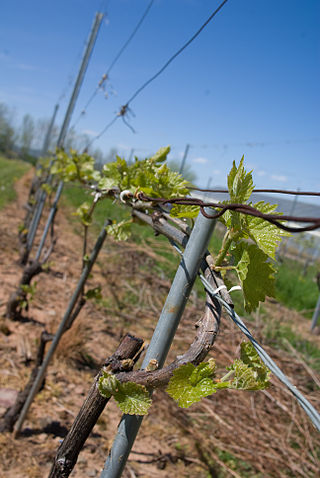
L'Acadie blanc is a white Canadian wine grape variety that is a hybrid crossing of Cascade and Seyve-Villard 14-287. The grape was created in 1953 by grape breeder Ollie A. Bradt in Niagara, Ontario at the Vineland Horticultural Research Station, which is now the Vineland Research and Innovation Centre. Today the grape is widely planted in Nova Scotia with some plantings in Quebec and Ontario. Some wine writers, including those at Appellation America, consider L'Acadie blanc as "Nova Scotia’s equivalent to Chardonnay".
Landal noir is a red hybrid grape variety that was created during a series of trials between 1929 and 1942 by French grape breeder Pierre Landot at his Conzieu nursery in the Ain department of eastern France. The grape is a crossing of two Seibel grapes, Plantet and Seibel 8216. While authorized for use in several French wine growing region, the grape is officially not recommended for use in any quality wine production in France with only 49 hectares of the variety reported in 2008. Outside France, some plantings of Landal noir can be found in Switzerland, Canada and the United States.

